Blackleg Yield Losses and Interactions with Verticillium Stripe in Canola (Brassica napus) in Canada
Abstract
1. Introduction
2. Results
2.1. Field Experiments for Blackleg Yield Losses
2.2. Blackleg Yield Losses in Commercial Crops
2.3. Field Experiments for Blackleg and Verticillium Stripe Interactions
2.4. Comparison of Symptoms and Signs on Canola
2.5. Greenhouse Experiments for Blackleg and Verticillium Stripe Interactions
3. Discussion
4. Materials and Methods
4.1. Inoculum Preparation
4.2. Field Experiments for Blackleg Yield Losses
4.3. Blackleg Yield Losses in Commercial Crops
4.4. Field Experiments for Blackleg and Verticillium Stripe Interactions
4.5. Greenhouse Experiments for Blackleg and Verticillium Stripe Interactions
4.6. Disease Assessments
4.7. Statistical Analysis
5. Conclusions
Author Contributions
Funding
Data Availability Statement
Acknowledgments
Conflicts of Interest
References
- Gugel, R.; Petrie, G. History, occurrence, impact, and control of blackleg of rapeseed. Can. J. Plant Pathol. 1992, 14, 36–45. [Google Scholar] [CrossRef]
- Salisbury, P.A.; Ballinger, D.J.; Wratten, N.; Plummer, K.M.; Howlett, B.J. Blackleg disease on oilseed brassica in Australia: A review. Aust. J. Exp. Agric. 1995, 35, 665–672. [Google Scholar] [CrossRef]
- West, J.S.; Kharbanda, P.D.; Barbetti, M.J.; Fitt, B.D. Epidemiology and management of Leptosphaeria maculans (phoma stem canker) on oilseed rape in Australia, Canada and Europe. Plant Pathol. 2001, 50, 10–27. [Google Scholar] [CrossRef]
- Howlett, B.J.; Idnurm, A.; Pedras, M.C. Leptosphaeria maculans, the causal agent of blackleg disease of Brassicas. Fungal Genet. Biol. 2001, 33, 1–14. [Google Scholar] [CrossRef]
- Akhavan, A.; Peru, C.; Dolatabadian, A.; Fernando, D.; Giroyed, J.; Esau, B.; Jacob, C.; Ippolito, J.; Kindrachuk, K.; Miller, S.; et al. Survey of canola diseases in Saskatchewan, 2021. Can. Plant Dis. Surv. 2020, 102, 124–128. [Google Scholar]
- Harding, M.W.; Daniels, G.C.; Hill, T.; Kennedy, M.A.; Sarkes, A.; Yang, Y.; Feng, J. Canola disease survey in Alberta, 2021. Can. Plant Dis. Surv. 2022, 102, 110–113. [Google Scholar]
- Kim, Y.M.; Kaminski, D.; Graham, J.; Pradhan, M.; Bargen, E.; Brackenreed, A.; Buss, T.; Clouson, N.; Cornelsen, J.; Cummer, T.; et al. Survey of canola diseases in Manitoba in 2021. Can. Plant Dis. Surv. 2022, 102, 151–154. [Google Scholar]
- Kutcher, H.R.; Brandt, S.A.; Smith, E.G.; Ulrich, D.; Malhi, S.S.; Johnston, A.M. Blackleg disease of canola mitigated by resistant cultivars and four-year crop rotations in western Canada. Can. J. Plant Pathol. 2013, 35, 209–221. [Google Scholar] [CrossRef]
- Zhang, X.; Peng, G.; Kutcher, H.R.; Balesdent, M.; Delourme, R.; Fernando, W.G. Breakdown of Rlm3 resistance in the Brassica napus–Leptosphaeria maculans pathosystem in Western Canada. Eur. J. Plant Pathol. 2016, 145, 659–674. [Google Scholar] [CrossRef]
- Rashid, M.H.; Liban, S.; Zhang, X.; Parks, P.; Borhan, H.; Fernando, W.G. Impact of Brassica napus–Leptosphaeria maculans interaction on the emergence of virulent isolates of L. maculans, causal agent of blackleg disease in Canola. Plant Pathol. 2020, 70, 459–474. [Google Scholar] [CrossRef]
- Hall, R.; Peters, R.; Assabgui, R. Occurrence and impact of blackleg on oilseed rape in Ontario. Can. J. Plant Pathol. 1993, 15, 305–313. [Google Scholar] [CrossRef]
- Barbetti, M.J.; Khangura, R.K. Managing blackleg in the disease-prone environment of Western Australia. In Proceedings of the 10th International Rapeseed Congress, Canberra, NSW, Australia, 26–29 September 1999. [Google Scholar]
- Zhou, Y.; Fitt, B.D.; Welham, S.J.; Gladders, P.; Sansford, C.E.; West, J.S. Effects of severity and timing of stem canker (Leptosphaeria maculans) symptoms on yield of winter oilseed rape (Brassica napus) in the UK. Eur. J. Plant Pathol. 1999, 105, 715–728. [Google Scholar] [CrossRef]
- Hwang, S.F.; Strelkov, S.E.; Peng, G.; Ahmed, H.; Zhou, Q.; Turnbull, G. Blackleg (Leptosphaeria maculans) severity and yield loss in canola in Alberta, Canada. Plants 2016, 5, 31. [Google Scholar] [CrossRef] [PubMed]
- Wang, Y.; Strelkov, S.E.; Hwang, S.F. Yield losses in Canola in response to blackleg disease. Can. J. Plant Sci. 2020, 100, 488–494. [Google Scholar] [CrossRef]
- Canola Council of Canada. Canola Encyclopedia: Blackleg in Canola. 2022. Available online: https://www.canolacouncil.org/canola-encyclopedia/diseases/blackleg/#genetic-resistance (accessed on 20 August 2022).
- Canadian Food Inspection Agency. Verticillium Stripe—Verticillium longisporum. 2 September 2018. Available online: https://inspection.canada.ca/plant-health/invasive-species/plant-diseases/verticillium-stripe/eng/1420746212959/1420746213803 (accessed on 20 August 2022).
- Depotter, J.R.; Deketelaere, S.; Inderbitzin, P.; Tiedemann, A.V.; Höfte, M.; Subbarao, K.V.; Wood, T.A.; Thomma, B.P. Verticillium longisporum, the invisible threat to oilseed rape and other brassicaceous plant hosts. Mol. Plant Pathol. 2016, 17, 1004–1016. [Google Scholar] [CrossRef]
- Rimmer, S.R.; Shattuck, V.; Buchwaldt, L. Verticillium Wilt. In Compendium of Brassica Diseases; American Phytopathological Society: St. Paul, MN, USA, 2007. [Google Scholar]
- Mengistu, A.; Rimmer, S.R.; Kock, E.; Williams, P.H. Pathogenicity grouping of isolates of Leptosphaeria maculans on Brassica napus cultivars and their disease reaction profiles on rapid-cycling Brassica. Plant Dis. 1991, 75, 1279–1282. [Google Scholar] [CrossRef]
- Rong, S.; Feng, J.; Li, Q.; Fei, W.; Ahmed, H.U.; Liang, Y.; Hwang, S.F.; Strelkov, S.E. Pathogenic variability and prevalence of Avr genes in Leptosphaeria maculans populations from Alberta, Canada. J. Plant Dis. Prot. 2015, 122, 161–168. [Google Scholar] [CrossRef]
- Kutcher, H.R.; Balesdent, M.H.; Rimmer, S.R.; Rouxel, T.; Chèvre, A.M.; Delourme, R.; Brun, H. Frequency of avirulence genes in Leptosphaeria maculans in western Canada. Can. J. Plant Pathol. 2010, 32, 77–85. [Google Scholar] [CrossRef]
- Chen, Y.; Fernando, W. Prevalence of pathogenicity groups of Leptosphaeria maculans in western Canada and North Dakota, USA. Can. J. Plant Pathol. 2006, 28, 533–539. [Google Scholar] [CrossRef]
- Zhang, X.; Fernando, W.G. Insights into fighting against blackleg disease of Brassica napus in Canada. Crop Pasture Sci. 2017, 69, 40–47. [Google Scholar] [CrossRef]
- Balesdent, M.H.; Barbetti, M.J.; Li, H.; Sivasithamparam, K.; Gout, L.; Rouxel, T. Analysis of Leptosphaeria maculans race structure in a worldwide collection of isolates. Phytopathology 2005, 95, 1061–1071. [Google Scholar] [CrossRef] [PubMed]
- Hall, R. Epidemiology of blackleg of oilseed rape. Can. J. Plant Pathol. 1992, 14, 46–55. [Google Scholar] [CrossRef]
- Total Precipitation—Quarterly Data Seasonal for Edmonton. Amateur Weather Statistics for Edmonton, Alberta. 16 November 2022. Available online: https://edmonton.weatherstats.ca/charts/precipitation-squarterly.html (accessed on 16 November 2022).
- Bokor, A.; Barbetti, M.J.; Brown, A.G.P.; MacNish, G.C.; Wood, P. McR. Blackleg of rapeseed. J. Agric. West. Aust. 1975, 16, 7–10. [Google Scholar]
- Howlett, B.J. Current knowledge of the interaction between Brassica napus and Leptosphaeria maculans. Can. J. Plant Pathol. 2004, 26, 245–252. [Google Scholar] [CrossRef]
- Rouxel, T.; Balesdent, M.H. The stem canker (blackleg) fungus, Leptosphaeria maculans, enters the genomic era. Mol. Plant Pathol. 2005, 6, 225–241. [Google Scholar] [CrossRef] [PubMed]
- Oosterhuis, K. Canola School: Verticillium Stripe Continues to Widen Its Path across the Prairies; Realagriculture: Lethbridge, AB, Canada, 2022. [Google Scholar]
- Barbetti, M.J.; Khangura, R.K. Fungal Diseases of Canola in Western Australia; Agriculture Western Australia: Perth, WA, Australia, 2000. [Google Scholar]
- Cui, J.; Strelkov, S.E.; Fredua-Agyeman, R.; Hwang, S.F. Development of optimized Verticillium Longisporum inoculation techniques for Canola (Brassica napus). Can. J. Plant Pathol. 2022, 1–11. [Google Scholar]
- Canola Council of Canada. How to Identify Verticillium Stripe. 2 September 2020. Available online: https://www.canolacouncil.org/canola-watch/2020/09/02/not-quite-blackleg-or-sclerotinia-could-be-verticillium/ (accessed on 20 August 2022).
- Dutt, A.; Andrivon, D.; Le May, C. Multi-infections, competitive interactions, and pathogen coexistence. Plant Pathol. 2022, 71, 5–22. [Google Scholar] [CrossRef]
- Toscano-Underwood, C.; Huang, Y.J.; Fitt, B.D.L.; Hall, A.M. Effects of temperature on maturation of pseudothecia of Leptosphaeria maculans and L. biglobosa on oilseed rape stem debris. Plant Pathol. 2003, 52, 726–736. [Google Scholar] [CrossRef]
- Al-Naimi, F.A.; Garrett, K.A.; Bockus, W.W. Competition, Facilitation, and Niche Differentiation in Two Foliar Pathogens. Oecologia 2005, 143, 449–457. [Google Scholar] [CrossRef]
- Hwang, S.F.; Ahmed, H.U.; Turnbull, G.D.; Gossen, B.D.; Strelkov, S.E. The effect of seed size, seed treatment, seeding date and depth on Rhizoctonia seedling blight of canola. Can. J. Plant Sci. 2014, 94, 311–321. [Google Scholar] [CrossRef]
- Madden, L.M.; Hughes, G. Sampling for plant disease incidence. Phytopathology 1999, 89, 1088–1103. [Google Scholar] [CrossRef] [PubMed]
- Guo, X.W.; Fernando, W.G. Seasonal and diurnal patterns of spore dispersal by Leptosphaeria maculans from Canola stubble in relation to environmental conditions. Plant Dis. 2005, 89, 97–104. [Google Scholar] [CrossRef] [PubMed]

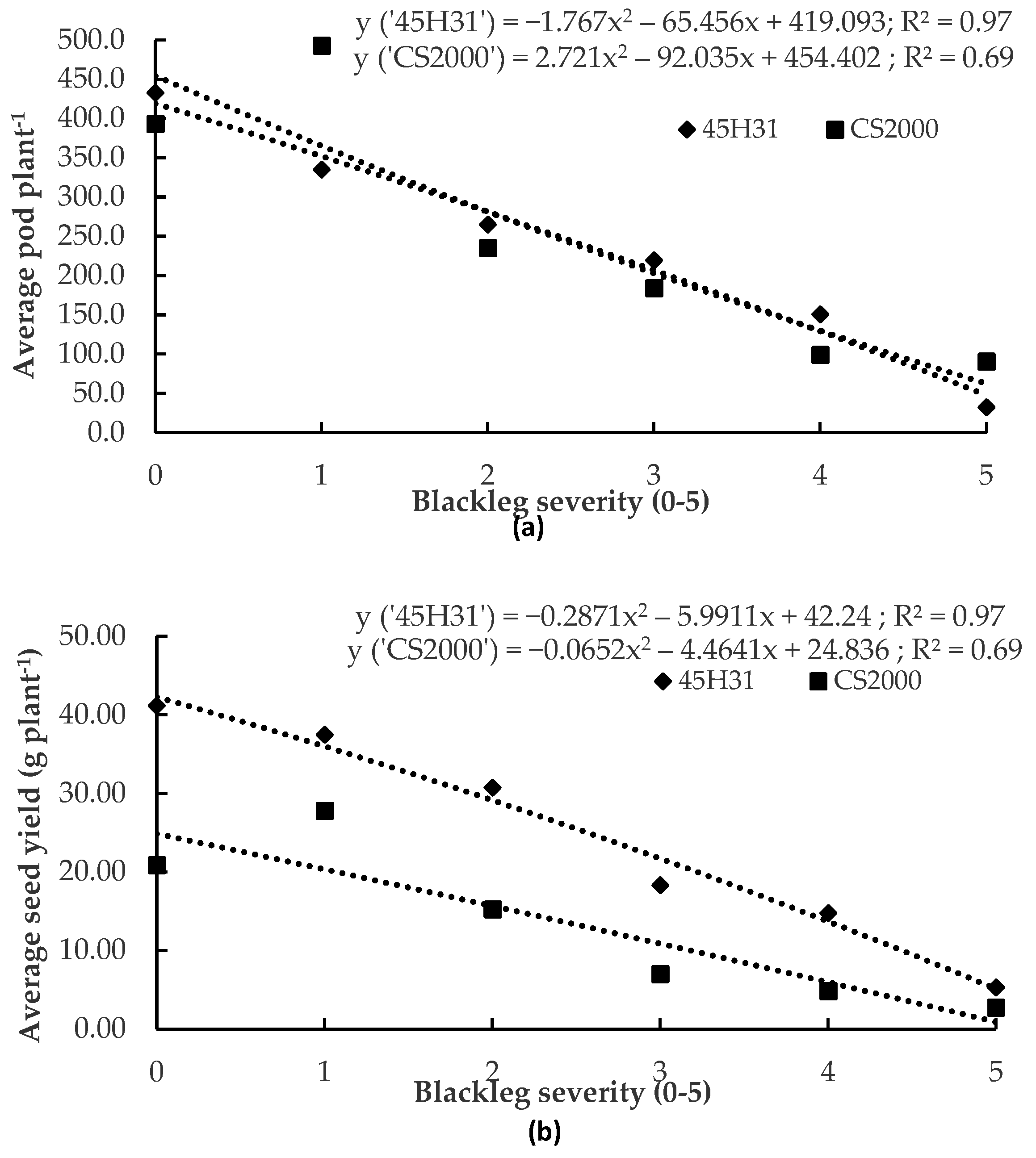
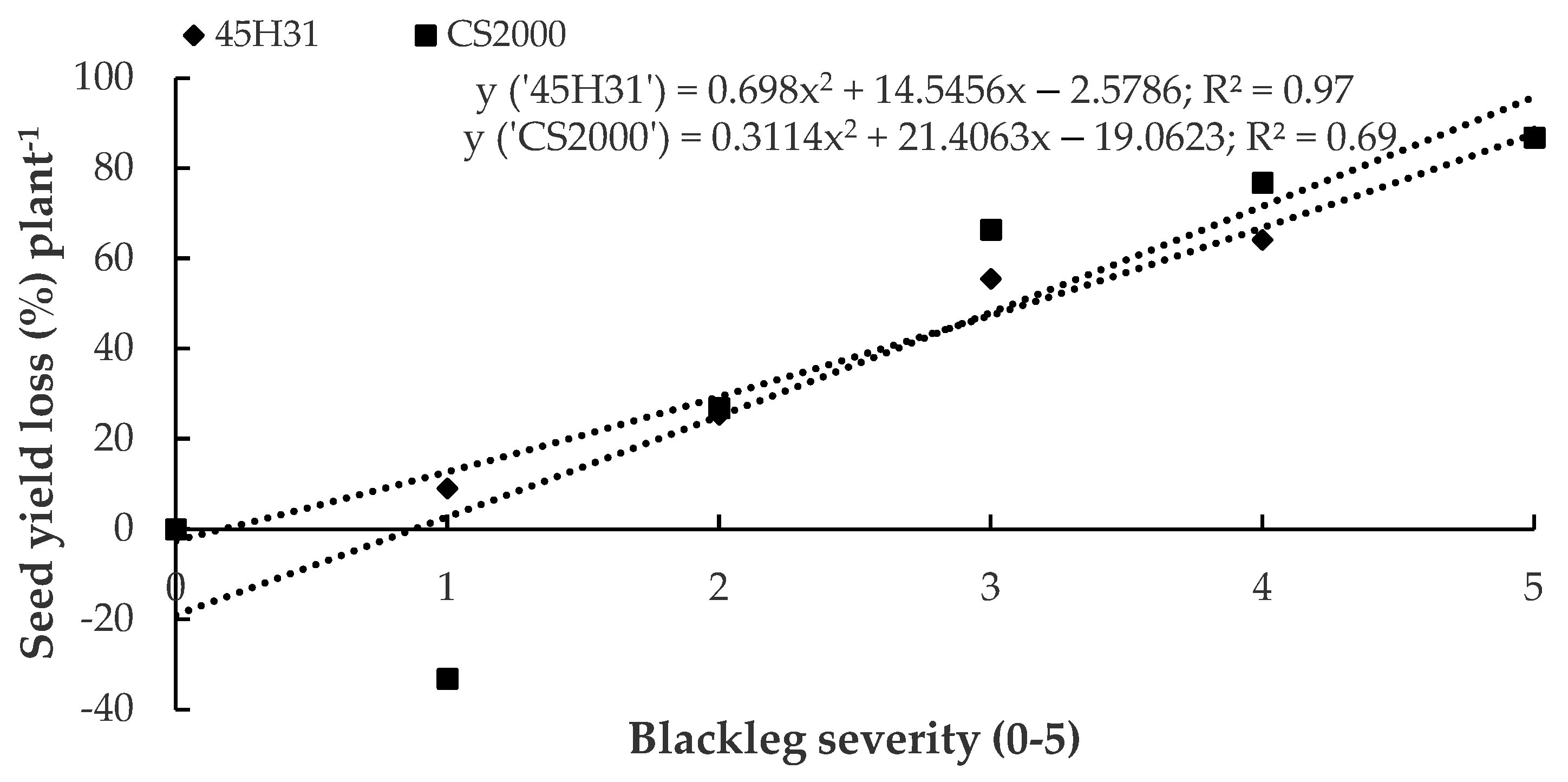
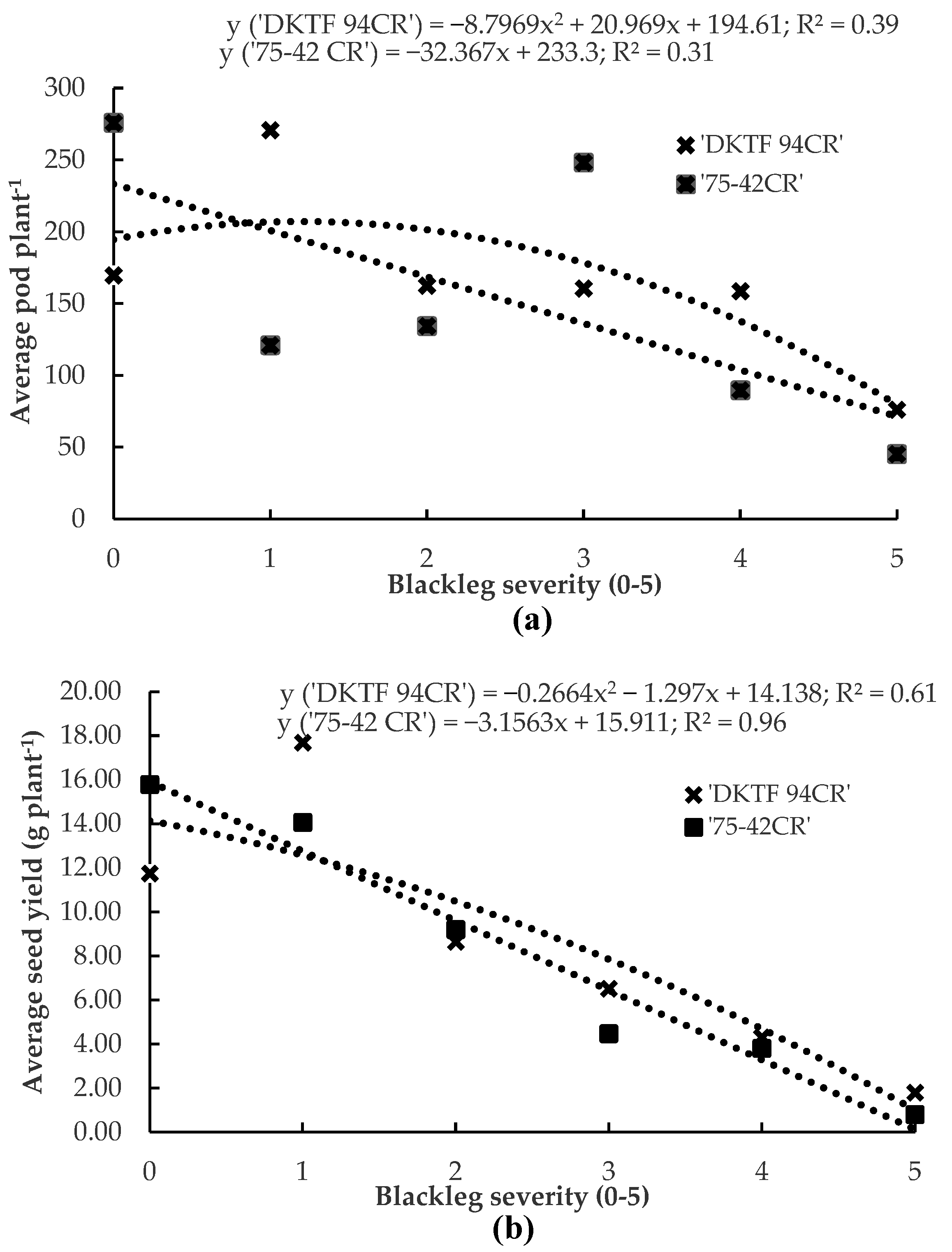
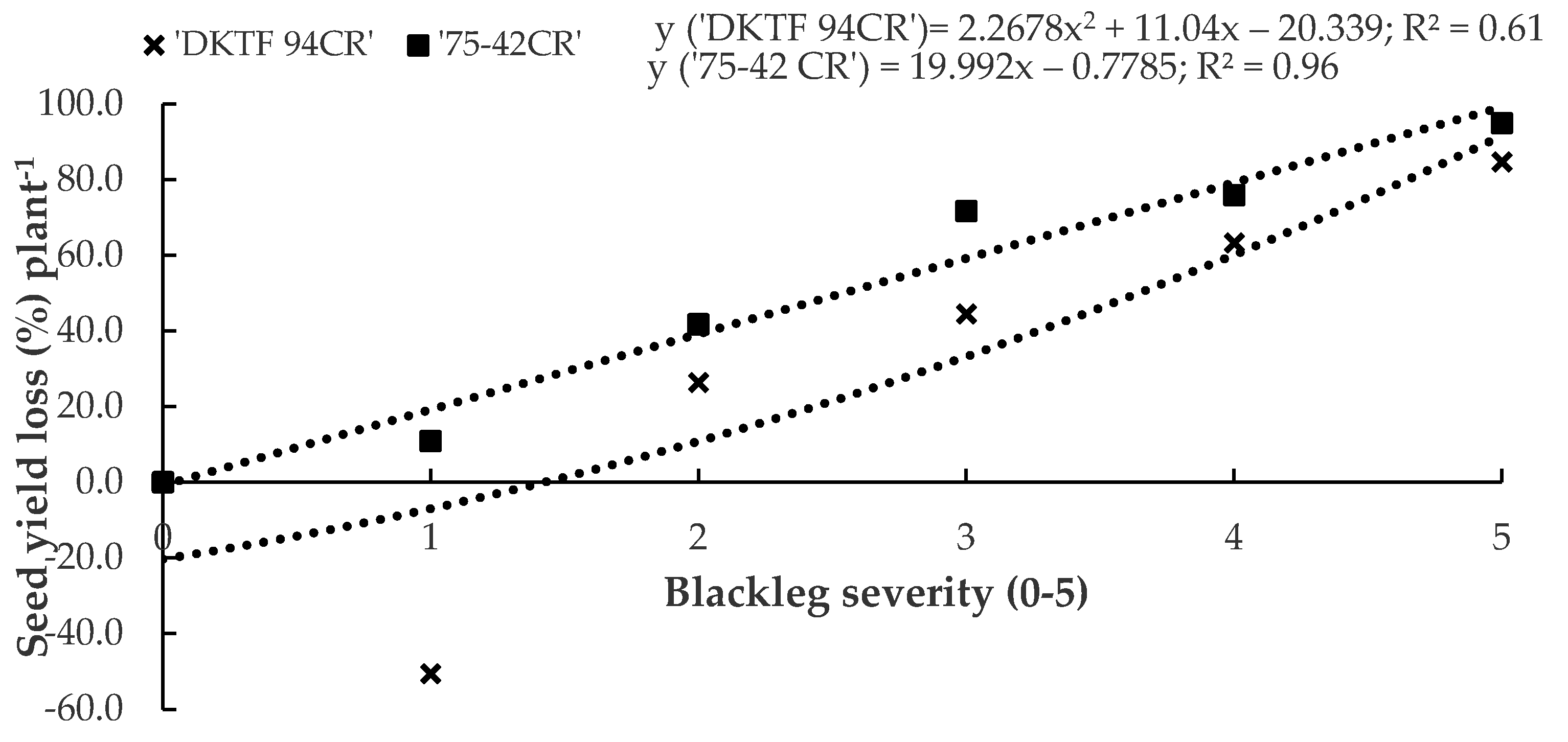
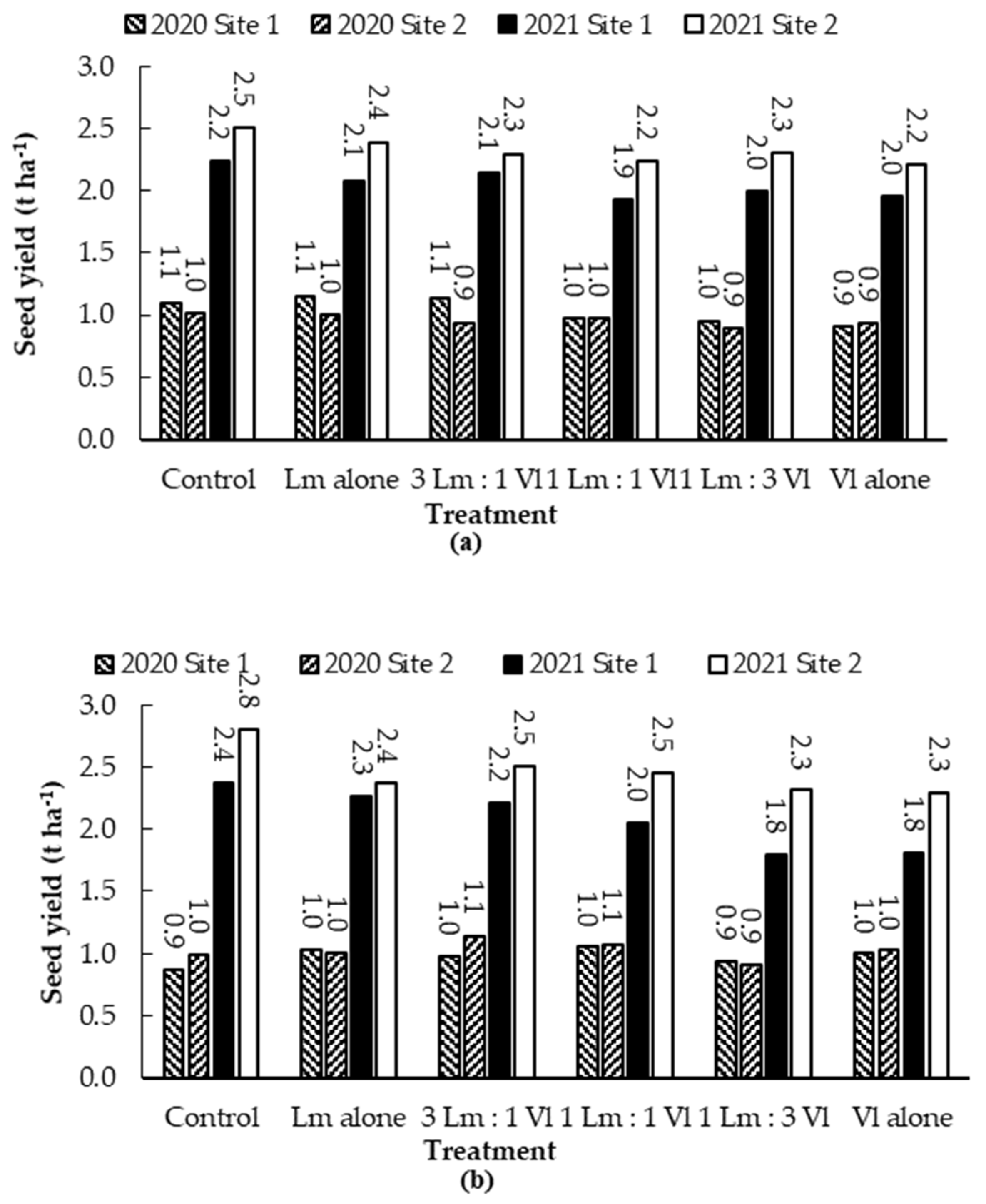

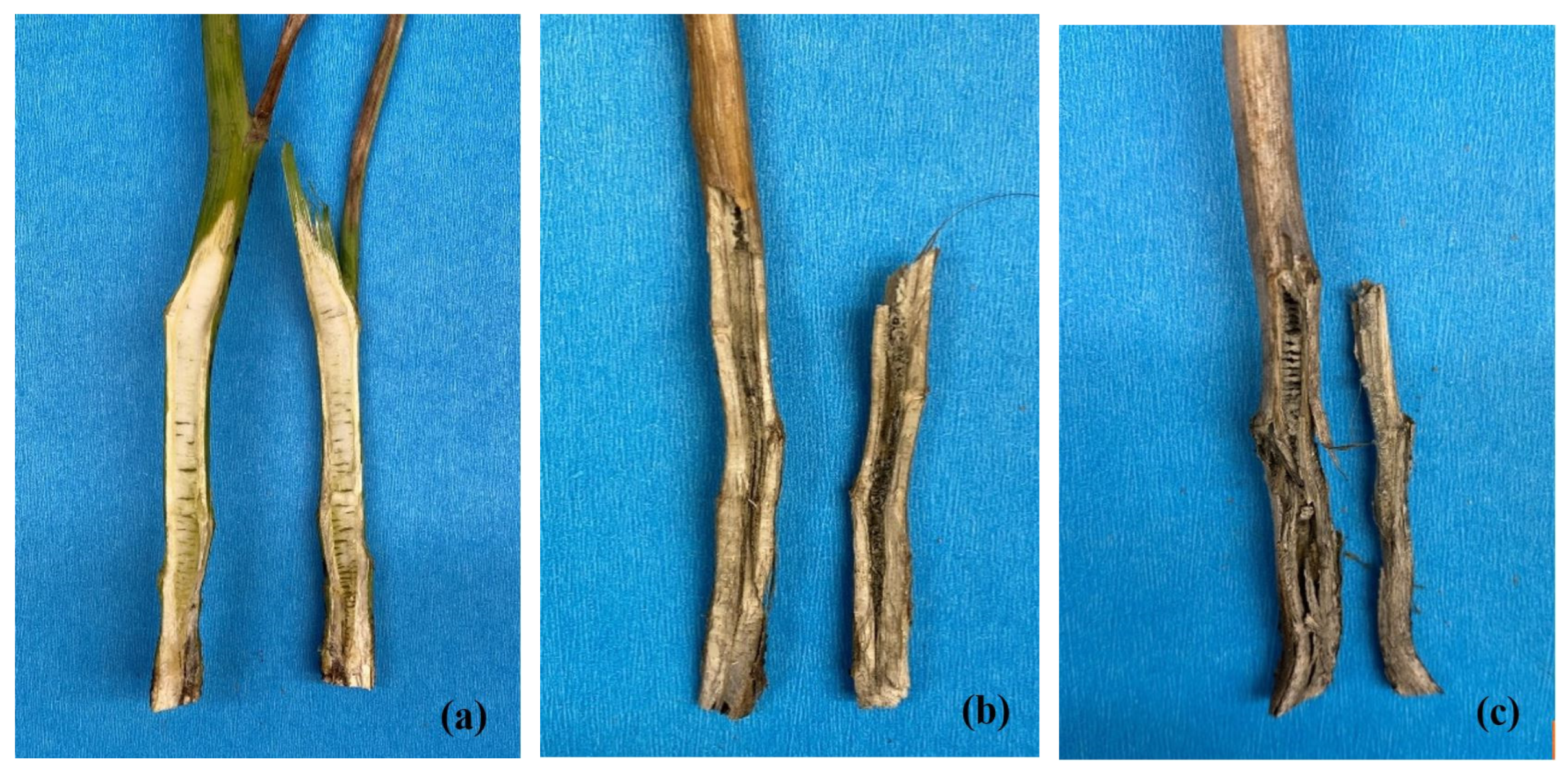
| Year | Treatment | ‘45H31’ | ‘CS2000’ |
|---|---|---|---|
| 2019 | Non-inoculated | 3.47 a 1 | 2.72 a |
| Inoculated | 2.18 b | 1.87 b | |
| 2020 | Non-inoculated | 1.05 A | 0.88 A |
| Inoculated | 1.00 A | 0.82 A |
| Treatment 1 | 2020 | 2021 | ||||||
|---|---|---|---|---|---|---|---|---|
| Site 1 | Site 2 | Site 1 | Site 2 | |||||
| ‘45H31’ | ‘CS2000’ | ‘45H31’ | ‘CS2000’ | ‘45H31’ | ‘CS2000’ | ‘45H31’ | ‘CS2000’ | |
| Control | 0.4 d 2 | 0.2 B | 0.1 b | 0.1 B | 0.5 c | 0.2 C | 0.6 bc | 0.0 C |
| Lm alone | 1.0 bcd | 0.9 A | 0.7 ab | 0.8 A | 1.5 a | 1.1 A | 1.0 a | 1.2 A |
| 3 Lm: 1 Vl | 1.3 abc | 0.9 A | 1.2 a | 1.0 A | 1.0 ab | 0.6 B | 0.4 bc | 0.4 BC |
| 1 Lm: 1 Vl | 1.6 a | 1.0 A | 1.5 a | 0.8 A | 0.6 ab | 0.6 BC | 0.3 b | 0.6 AB |
| 1 Lm: 3 Vl | 1.1 cd | 0.9 A | 0.9 ab | 0.9 A | 0.3 bc | 0.5 B | 0.4 bc | 0.3 BC |
| Vl alone | 1.5 ab | 1.3 A | 1.0 ab | 1.2 A | 0.7 c | 0.3 BC | 0.6 c | 0.4 BC |
| Treatment 1 | 2020 | 2021 | ||||||
|---|---|---|---|---|---|---|---|---|
| Site 1 | Site 2 | Site 1 | Site 2 | |||||
| ‘45H31’ | ‘CS2000’ | ‘45H31’ | ‘CS2000’ | ‘45H31’ | ‘CS2000’ | ‘45H31’ | ‘CS2000’ | |
| Control | 0.0 c 2 | 0.1 C | 0.0 a | 0.2 B | 0.5 b | 0.2 C | 0.6 c | 0.0 B |
| Lm alone | 0.3 b | 0.3 BC | 0.0 a | 0.2 B | 1.1 b | 0.4 C | 1.1 c | 0.2 B |
| 3 Lm: 1 Vl | 0.4 ab | 0.3 ABC | 0.4 a | 0.3 AB | 1.0 a | 0.5 BC | 2.2 b | 1.5 A |
| 1 Lm: 1 Vl | 0.4 ab | 0.6 AB | 0.2 a | 0.2 AB | 1.0 a | 0.8 ABC | 1.7 b | 1.8 A |
| 1 Lm: 3 Vl | 0.2 bc | 0.5 ABC | 0.2 a | 0.2 AB | 1.1 a | 1.2 AB | 1.8 a | 1.6 A |
| Vl alone | 0.5 a | 0.7 A | 0.3 a | 0.6 A | 1.2 a | 1.6 A | 1.9 a | 2.0 A |
| Treatment 1 | Emergence (%) 2 | Blackleg Severity (0–5) | Verticillium stripe Severity (0–4) | Yield (g plant−1) | ||||
|---|---|---|---|---|---|---|---|---|
| ‘45H31’ | ‘CS2000’ | ‘45H31’ | ‘CS2000’ | ‘45H31’ | ‘CS2000’ | ‘45H31’ | ‘CS2000’ | |
| Control | 94.7 a | 95.0 A | 0.0 d | 0.0 C | 0.0 c | 0.0 B | 1.5 c | 1.2 B |
| Lm alone | 41.6 c | 52.5 B | 0.9 b | 0.8 AB | 0.0 c | 0.0 B | 3.9 a | 2.3 A |
| 3 Lm: 1 Vl | 42.2 c | 52.5 B | 1.3 a | 1.0 A | 1.0 b | 1.6 A | 3.8 a | 2.0 AB |
| 1 Lm: 1 Vl | 54.7 b | 62.2 B | 0.9 bc | 0.8 AB | 1.0 b | 1.7 A | 3.4 ab | 1.8 AB |
| 1 Lm: 3 Vl | 57.2 b | 63.8 B | 0.6 c | 0.6 B | 1.3 b | 1.8 A | 2.7 b | 1.7 AB |
| Vl alone | 55.6 b | 51.9 B | 0.0 d | 0.0 C | 1.9 a | 1.9 A | 1.6 c | 1.4 B |
Disclaimer/Publisher’s Note: The statements, opinions and data contained in all publications are solely those of the individual author(s) and contributor(s) and not of MDPI and/or the editor(s). MDPI and/or the editor(s) disclaim responsibility for any injury to people or property resulting from any ideas, methods, instructions or products referred to in the content. |
© 2023 by the authors. Licensee MDPI, Basel, Switzerland. This article is an open access article distributed under the terms and conditions of the Creative Commons Attribution (CC BY) license (https://creativecommons.org/licenses/by/4.0/).
Share and Cite
Wang, Y.; Strelkov, S.E.; Hwang, S.-F. Blackleg Yield Losses and Interactions with Verticillium Stripe in Canola (Brassica napus) in Canada. Plants 2023, 12, 434. https://doi.org/10.3390/plants12030434
Wang Y, Strelkov SE, Hwang S-F. Blackleg Yield Losses and Interactions with Verticillium Stripe in Canola (Brassica napus) in Canada. Plants. 2023; 12(3):434. https://doi.org/10.3390/plants12030434
Chicago/Turabian StyleWang, Yixiao, Stephen E. Strelkov, and Sheau-Fang Hwang. 2023. "Blackleg Yield Losses and Interactions with Verticillium Stripe in Canola (Brassica napus) in Canada" Plants 12, no. 3: 434. https://doi.org/10.3390/plants12030434
APA StyleWang, Y., Strelkov, S. E., & Hwang, S.-F. (2023). Blackleg Yield Losses and Interactions with Verticillium Stripe in Canola (Brassica napus) in Canada. Plants, 12(3), 434. https://doi.org/10.3390/plants12030434







